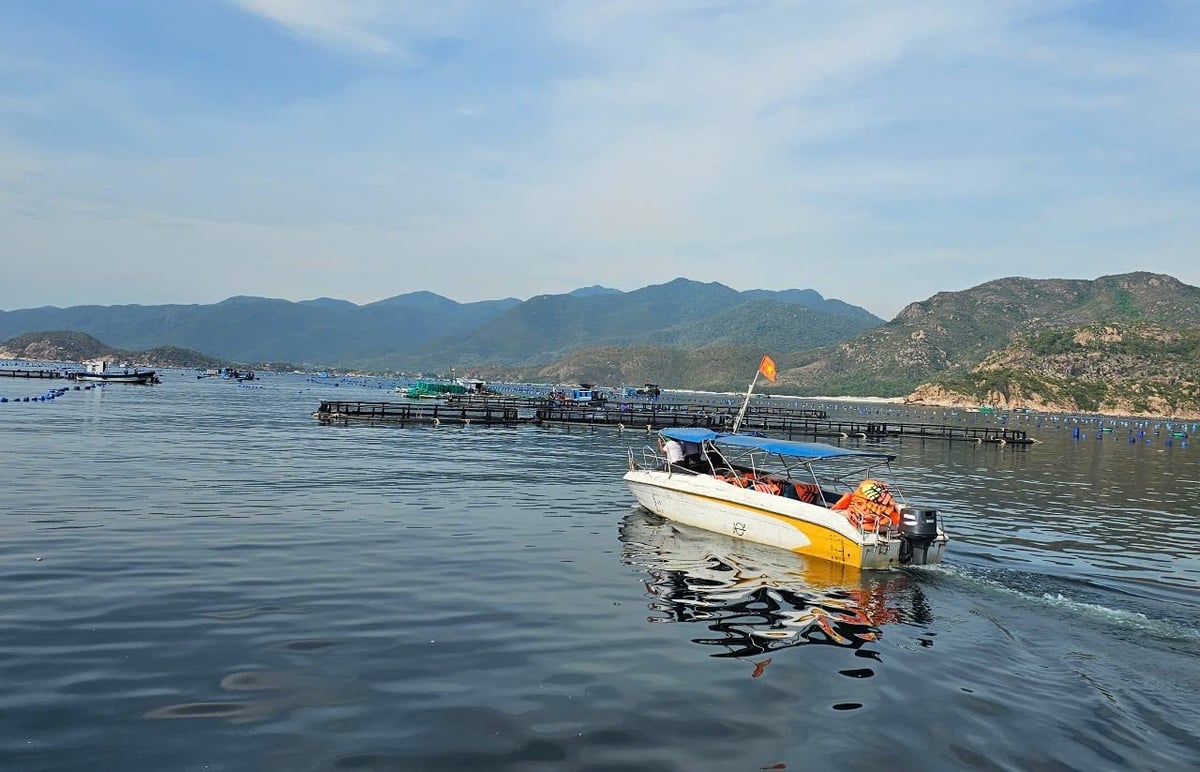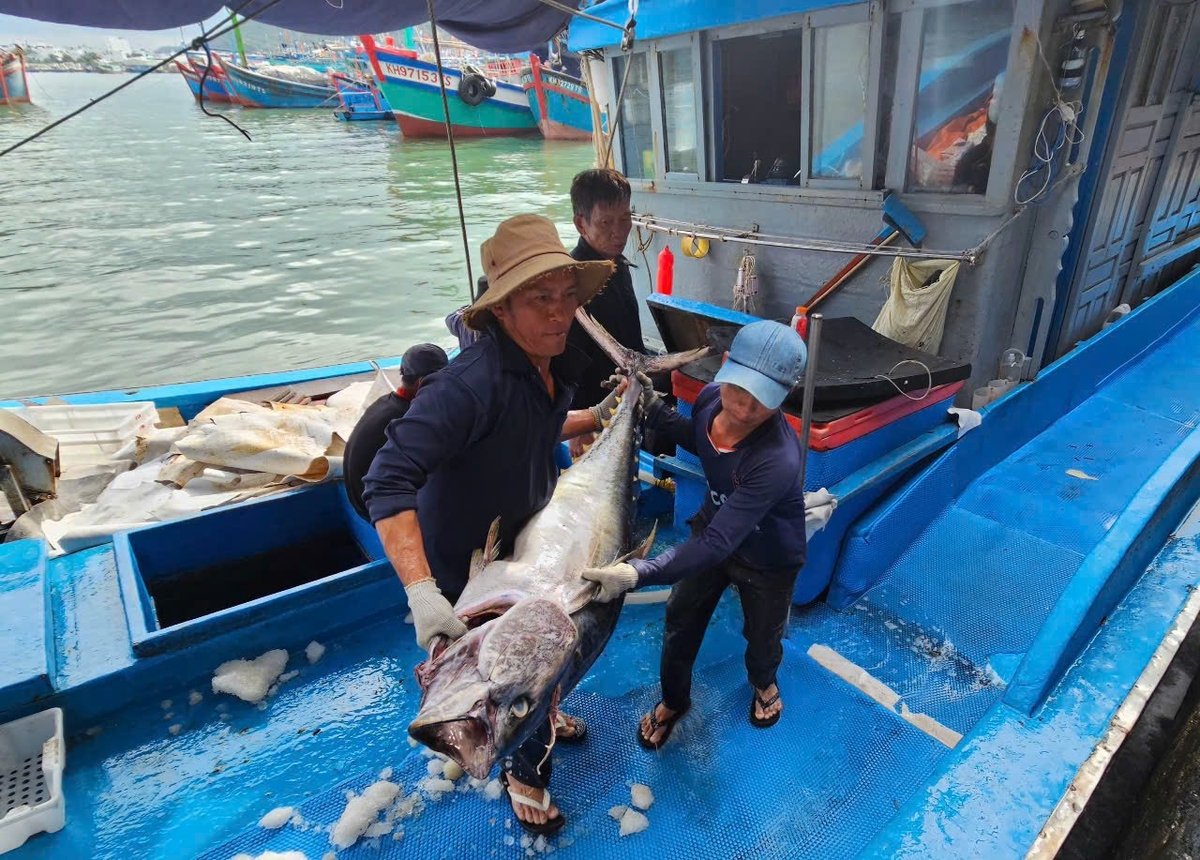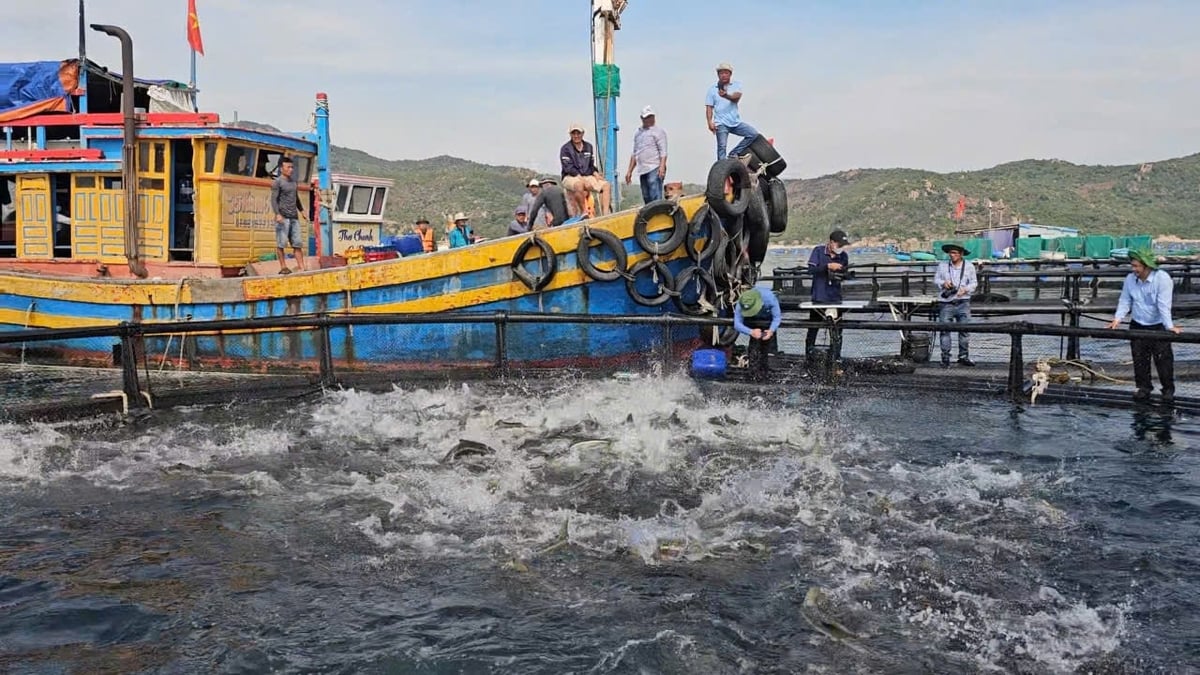December 31, 2025 | 02:42 GMT +7
December 31, 2025 | 02:42 GMT +7
Hotline: 0913.378.918
December 31, 2025 | 02:42 GMT +7
Hotline: 0913.378.918
With a 385km coastline, more than 200 islands of varying sizes, numerous sheltered harbors and lagoons, and numerous deep-water ports, Khanh Hoa Province has a strategic advantage for developing the fisheries sector.

Khanh Hoa has many potentials and advantages to develop aquaculture. Photo: KS.
The province currently has 3,416 fishing vessels, including 633 boats 15 meters or longer. These vessels mainly operate offshore and target yellowfin and skipjack tuna.
In 2024, the Khanh Hoa Department of Agriculture and Environment anticipates that the province's seafood catch will amount to 103,000 tonnes, a minor increase of 0.2% from 2023.
In the meantime, Khanh Hoa's aquaculture sector encompasses nearly 4,300 hectares, primarily focusing on cultivating spiny lobsters and a variety of marine fish species. Van Ninh, Ninh Hoa, Nha Trang, and Cam Ranh are the four agricultural zones where these activities are concentrated, resulting in a total output of over 22,570 tonnes, a 21% increase yearly.
Khanh Hoa is also a significant center for seafood processing and exports, with 149 processing facilities catering to the domestic market and 57 facilities certified for export. Tuna, shrimp, and other main export products are available in 64 countries and territories worldwide. Khanh Hoa is one of the top five seafood-exporting localities in Vietnam, with seafood exports comprising 35–44% of the province's total export value.

Khanh Hoa has a fleet specializing in catching ocean tuna. Photo: KS.
Khanh Hoa's seafood export revenue is anticipated to surpass USD 850 million in 2024, representing a 26.8% increase from the previous year. This figure will substantially contribute to the provincial expansion.
Nguyen Trong Chanh, the Deputy Director of the Department of Agriculture and Environment, observed that seafood exports from the province have experienced consistent growth in recent years. By 2025, the province intends to generate USD 1 billion in export revenue from the fisheries sector.
Khanh Hoa will implement comprehensive measures to enhance performance across capture fisheries, aquaculture, processing, and trade to achieve this objective. The Prime Minister's Decision No. 231 dated January 24, 2025, will serve as a critical guide for the expedited implementation of the pilot high-tech mariculture development project.
The department proposed on February 18 that the provincial People's Committee issue Plan No. 1884 to execute the project, which includes policies to incentivize the transition to high-tech marine aquaculture and the use of advanced materials, according to Mr. Chanh.
Subsidies for accident insurance for workers operating on marine aquaculture cages and related service vessels, disaster risk insurance for farmed species at sea, and funding for converting traditional cage materials to modern alternatives are among the specific support measures.

Khanh Hoa will expand high-tech marine farming to contribute to achieving its seafood export target. Photo: KS.
Furthermore, the province will implement a series of programs and solutions, including investing in aquaculture infrastructure, enhancing production management, attracting investment in fodder, breeding stock, farming technology, support services, and environmental monitoring and disease prevention. Workforce training, trade promotion, and market development are additional priorities.
Furthermore, the National Assembly's Resolution No. 55, dated June 16, 2022, initiates numerous special mechanisms and policies for the advancement of Khanh Hoa Province. It includes provisions regarding the allocation of sea area and tax incentives for marine aquaculture organizations and individuals.
Mr. Chanh expressed his confidence in the establishment of a favorable legal and business environment that will support fishers in expanding aquaculture efficiently and sustainably as a result of the current and upcoming fisheries development policies. This will contribute to the objective of achieving USD 1 billion in seafood export revenue.
It is worth noting that before the Prime Minister approved the high-tech mariculture pilot scheme, Khanh Hoa had already developed a pilot model for high-tech marine farming in open sea areas. After one year of implementation, the profitability of the HDPE cage farming systems employed in the pilot exceeded that of traditional wooden cages.
In particular, the cobia farming prototype generated an average profit margin of 172%, while the lobster farming model returned 112% and the grouper farming model exceeded 131%.
Khanh Hoa, in accordance with its provincial plan, intends to expand high-tech marine farming to approximately 240 hectares by 2029, with a total investment of over VND 545 billion. The province's primary objective is to transition from conventional wooden cages to HDPE cage systems.
*USD 1 = VND 25.730 (Source: Vietcombank)
Translated by Linh Linh
/2025/12/25/2157-2-170845_745.jpg)
(VAN) Amid the impacts of climate change and market competition, An Giang's agriculture is shifting toward a green, modern growth model, creating a key driving force for restructuring the sector.

(VAN) Two leading enterprises in the agricultural sector have officially cooperated to implement a sustainable value chain model for Viet Nam's shrimp industry.

(VAN) Dien Bien is speeding up ODA projects to respond to climate change and strengthen water management and disaster prevention infrastructure in pursuit of sustainable development.

(VAN) With high automation, large capacity, and a green development orientation, the Hai Duong Plant Branch is becoming an important anchor for the animal feed market.
/2025/12/01/2936-2-222331_70.jpg)
(VAN) Mortgaging his house and giving up a pharmaceutical management career, Mr. Nguyen Quang Duy succeeded in bringing Khanh Hoa's sea grapes to demanding markets such as Japan and the U.S.

(VAN) The large-scale agroforestry investment project aims to develop a leading sustainable agro-industrial center in Angola.
/2025/11/28/3433-1-212821_213.jpg)
(VAN) Many localities across the coconut land of Vinh Long are replicating emission-reducing models in production and daily life, contributing to the targets for emission reduction and green economic development.